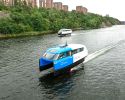Large language models can solve operational challenges

The integration of AI technologies, particularly large language models (LLMs), can not only solve today's operational challenges but also pave the way for future solutions that improve efficiency and strengthen sustainability in maritime shipping. This is demonstrated by a new pre-study from Lighthouse, the results of which exceeded expectations.
When researchers from RISE, Chalmers, and Linnaeus University examined last year how well ChatGPT and other language models could analyze traffic situations in a Lighthouse pre-study, the results were far from impressive. The AI tools simply lacked the ability to perform spatial reasoning, or, as one might say, a functioning sense of place. However, it is clear that a tool that can efficiently and quickly process large amounts of information must have some utility within maritime shipping. Therefore, a new pre-study project has explored the potential of using large language models (LLMs) for data analysis and decision support in maritime shipping, with a particular focus on how they can be applied to improve both operational efficiency and sustainability.
“Together with DNV, we identified various maritime challenges that we wanted to address. They are interested in integrating AI models into their existing software, a need also requested by their customers”, says Oxana Lundström, postdoctoral researcher at Linnaeus University, who led the work on the feasibility study Large Language Models (LLMs) in Maritime Data Analysis and Decision Support.
So how do you test AI applications in areas like route and schedule optimization, maintenance, emissions, and maritime safety? First and foremost, access to operational data from ships is required.
“It's a challenge. Shipping companies and private firms are reluctant to release operational data. Fortunately, the PONTOS database was developed in another project, which provided access to open data from several different ships. The Swedish Transport Administration also helped us through the Ferry Service with data.”
In a case study, they tested combining data collection with an AI-driven approach called Agentic Retrieval-Augmented Generation (RAG).
“Essentially, this means chatting with your own data. You can ask questions like: Which routes do I need to optimize? What patterns can we identify over a specific period? And so on. ChatGPT uses your contextual data to tailor the answers, relying not just on its training data”, explains Oxana Lundström.
She continues:
“It is also possible to link other modules to the LLMs. In this case, we connected the first module that can execute database queries. When a question is asked, the module converts it into a database query that retrieves relevant information. The LLM can also be connected to other modules, such as an agent that generates code to further process the data or trains machine learning models to uncover even more advanced insights.”
The tests exceeded expectations.
“After the navigation project, I was quite skeptical about whether this would work, but the system solved simple problems very well. With the latest LLM models, which were launched at the end of 2024 and can reason, it worked extremely well.”
According to the report, the integration of AI technologies, especially LLMs, offers great potential for the maritime sector. By strategically using these tools, the industry can manage current operational challenges and create future solutions to improve efficiency and strengthen sustainability.
However, integrating AI into ship data analysis poses several challenges, such as data security and compatibility with various systems. Future research should focus on creating an independent, secure AI application that works in cloud environments and ensures smooth data flow. It is also crucial to explore how to handle real-time data and optimize data volume for efficient analysis. Additionally, AI applications must be accurate and capable of managing "hallucinations" to provide reliable results, which is essential for the maritime industry to adapt to future challenges.
The pre-study Large Language Models (LLMs) in Maritime Data Analysis and Decision Support was authored by: Oxana Lundström, Postdoctoral researcher, Department of Computer Science and Media Technology, Linnaeus University, Kalmar Andreas Nilsson, Research Engineer, Department of Computer Science and Media Technology, Linnaeus University, Kalmar Michael Johansson, Head of Maritime Advisory Sweden & Denmark DNV, Gothenburg
-
 NextWave – en podd som ska locka unga
NextWave – en podd som ska locka unga -
 Ny studie: Eldrivna pendelbåtar kan effektivisera Stockholms kollektivtrafik
Ny studie: Eldrivna pendelbåtar kan effektivisera Stockholms kollektivtrafik -
 Sjöfartens utsläpp ökar
Sjöfartens utsläpp ökar -
 Sociala relationer påverkar val av bränsle
Sociala relationer påverkar val av bränsle -
 Sjöfartens omställning kräver ”mjukare” påtryckningar
Sjöfartens omställning kräver ”mjukare” påtryckningar -
 Hon hade avtalad tid med Kapten ynkrygg
Hon hade avtalad tid med Kapten ynkrygg -
 Lighthouse omvärldsanalys 2025 – osäkerhet och tullar präglar sjöfarten
Lighthouse omvärldsanalys 2025 – osäkerhet och tullar präglar sjöfarten -
 Se seminariet Shipping in the Marine Environment
Se seminariet Shipping in the Marine Environment -
 Vad betyder egentligen de 90 procenten?
Vad betyder egentligen de 90 procenten? -
 Hålla där...
Hålla där...

